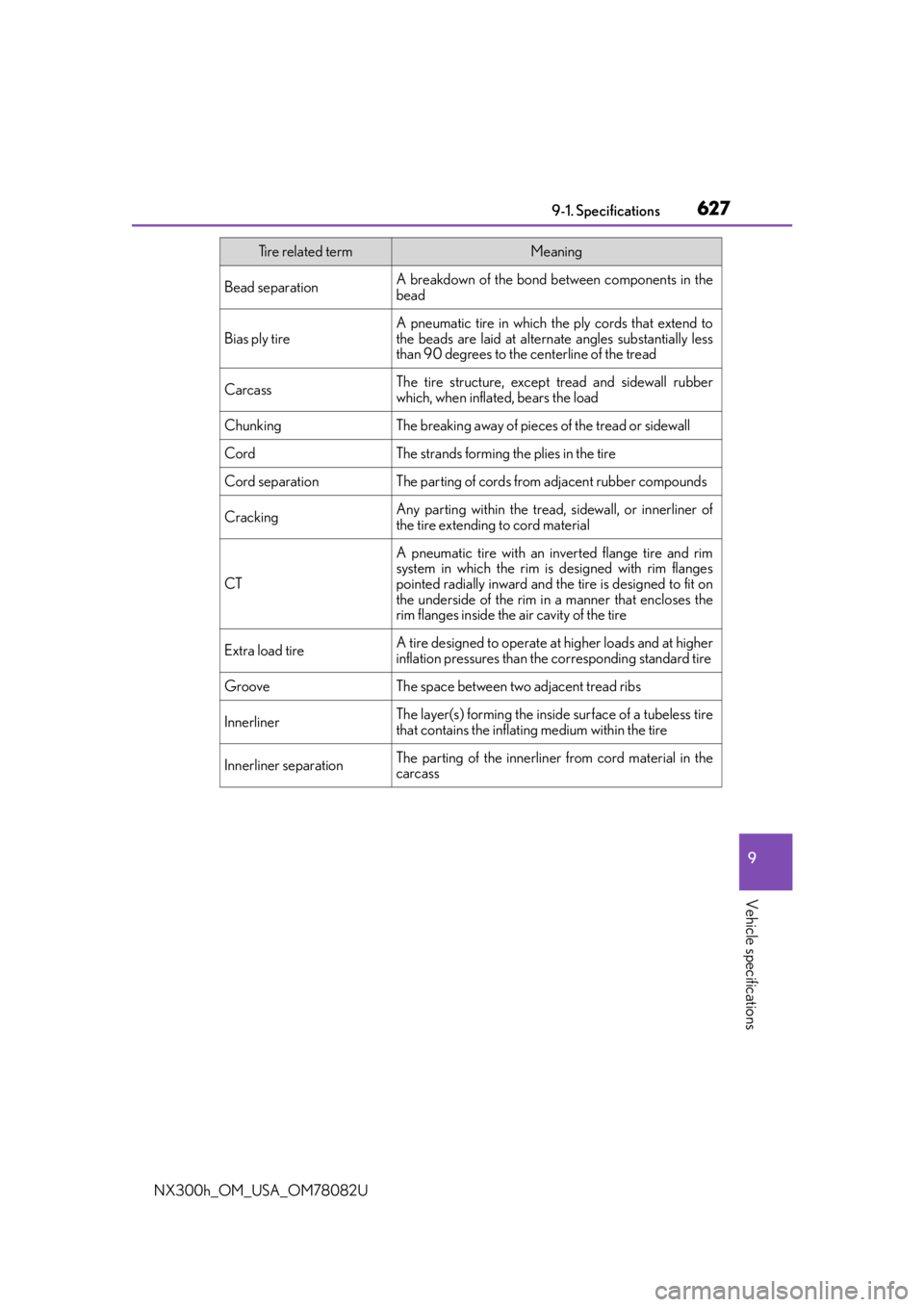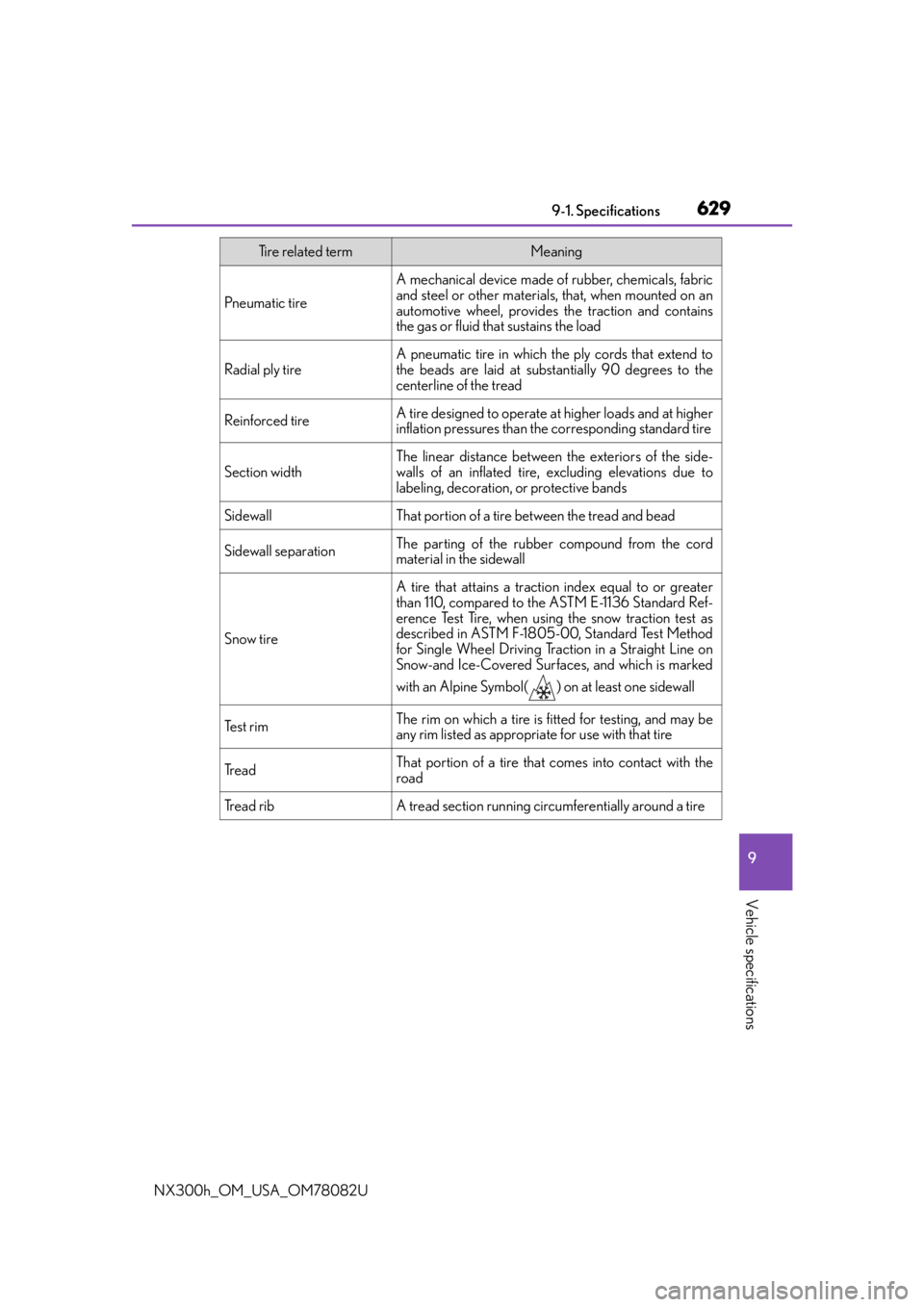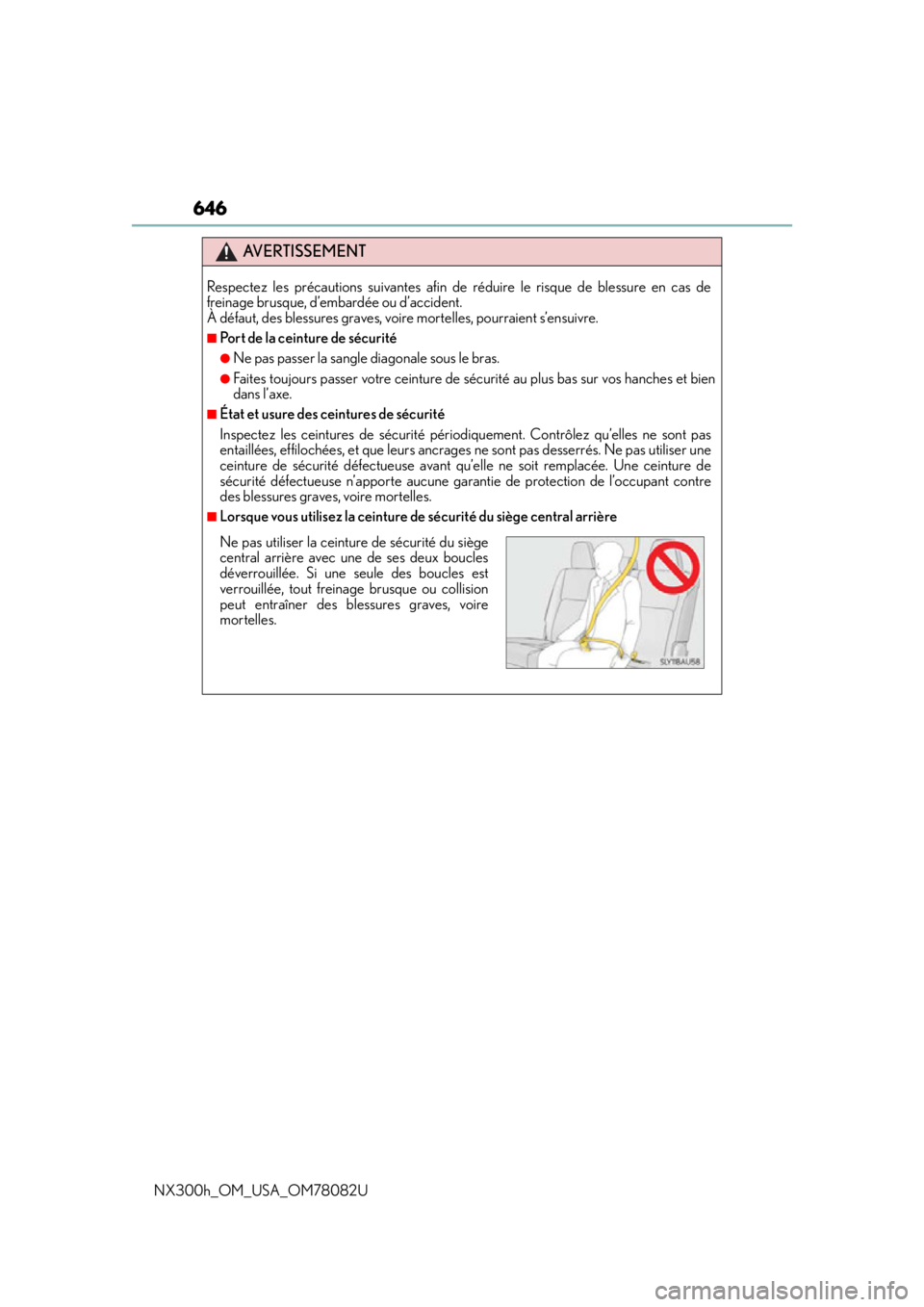ESP LEXUS NX300H 2016 Manual PDF
[x] Cancel search | Manufacturer: LEXUS, Model Year: 2016, Model line: NX300H, Model: LEXUS NX300H 2016Pages: 680, PDF Size: 10.23 MB
Page 571 of 680

5718-2. Steps to take in an emergency
8
When trouble arises
NX300h_OM_USA_OM78082U
WA R N I N G
■Maintenance of the tires
Each tire, including the spare (if provided), should be checked monthly when cold and
inflated to the inflation pressure recomm ended by the vehicle manufacturer on the
vehicle placard or tire inflation pressure la bel (tire and load information label). (If your
vehicle has tires of a different size than the size indicated on the vehicle placard or tire
inflation pressure label [tire and load in formation label], you should determine the
proper tire inflation pressure for those tires.)
As an added safety feature, your vehicle has been equipped with a tire pressure moni-
toring system (TPMS-tire pressure warning system) that illuminates a low tire pressure
telltale (tire pressure warning light) when on e or more of your tires is significantly
under-inflated. Accordingly, when the low ti re pressure telltale (tire pressure warning
light) illuminates, you should stop and check your tires as soon as possible, and inflate
them to the proper pressure. Driving on a significantly under-inflated tire causes the
tire to overheat and can lead to tire failure. Under-inflation also reduces fuel efficiency
and tire tread life, and ma y affect the vehicle’s handling and stopping ability.
Please note that the TPMS (tire pressure wa rning system) is not a substitute for proper
tire maintenance, and it is the driver’s resp onsibility to maintain correct tire pressure,
even if under-inflation has no t reached the level to trigger illumination of the TPMS low
tire pressure telltale (tire pressure warning light).
Your vehicle has also been equipped with a TPMS (tire pressure warning system) mal-
function indicator to indicate when the system is not operating properly. The TPMS
(tire pressure warning system) malfunction indi cator is combined with the low tire pres-
sure telltale (tire pressure warning light). When the system detects a malfunction, the
telltale will flash for approximately one minu te and then remain continuously illumi-
nated. This sequence will cont inue upon subsequent vehicle start-ups as long as the
malfunction exists. When the malfunction indicator is illuminated, the system may not
be able to detect or signal low tire pressure as intended.
TPMS (tire pressure warning system) malfun ctions may occur for a variety of reasons,
including the installation of replacement or alternate tires or wheels on the vehicle that
prevent the TPMS (tire pressure warning system) from functioning properly. Always
check the TPMS (tire pressure warning syst em) malfunction telltale after replacing one
or more tires or wheels on your vehicle to ensure that the replacement or alternate
tires and wheels allow the TPMS (tire pressure warning system) to continue to function
properly.
NOTICE
■To ensure the tire pressure warning system operates properly
Do not install tires with different specificatio ns or makers, as the tire pressure warning
system may not operate properly.
Page 596 of 680

5968-2. Steps to take in an emergency
NX300h_OM_USA_OM78082U
Start the engine of the second vehicle. Increase the engine speed slightly and
maintain at that level for approximately 5 minutes to recharge the 12-volt bat-
tery of your vehicle.
Open and close any of the doors of your vehicle with the power switch off.
Maintain the engine speed of the second vehicle and start the hybrid system
of your vehicle by turning the power switch to ON mode.
Make sure the “READY” indicator comes on. If the indicator light does not
come on, contact your Lexus dealer.
Once the hybrid system has started, remove the jumper cables in the exact
reverse order from which they were connected.
Close the exclusive jump starting terminal cover, and reinstall the fuse box
cover to its original position.
Once the hybrid system starts, have th e vehicle inspected at your Lexus dealer
as soon as possible.
■Starting the hybrid system when the 12-volt battery is discharged
The hybrid system cannot be started by push-starting.
■To prevent 12-volt battery discharge
●Turn off the headlights and the audio system while the hybrid system is off.
●Turn off any unnecessary electrical components when the vehicle is running at a low
speed for an extended period, such as in heavy traffic.
■Charging the 12-volt battery
The electricity stored in the 12-volt battery will discharge gradually even when the vehicle
is not in use, due to natural discharge and th e draining effects of certain electrical appli-
ances. If the vehicle is left for a long time, the 12-volt battery may discharge, and the
hybrid system may be unable to start. (The 12-volt battery recharges automatically while
the hybrid system is operating.)
■When the 12-volt battery is removed or discharged
●In some cases, it may not be possible to unlock the doors using the smart access system
with push-button start when the 12-volt battery is discharged. Use the wireless remote
control or the mechanical key to lock or unlock the doors.
●The hybrid system may not start on the first attempt after the 12-volt battery has
recharged but will start normally after the second attempt. This is not a malfunction.
●The power switch mode is memorized by the vehicle. When the 12-volt battery is
reconnected, the system will return to the mode it was in before the 12-volt battery was
discharged. Before disconnecting the 12-volt battery, turn the power switch off.
If you are unsure what mode the power switch was in before the 12-volt battery dis-
charged, be especially careful when reconnecting the 12-volt battery.
●The power back door must be initialized. ( P. 1 3 4 )
6
7
8
9
10
11
Page 602 of 680

6028-2. Steps to take in an emergency
NX300h_OM_USA_OM78082U
Start the hybrid system and check if “Hybrid System Overheated” is shown
on the multi-information display.
If the message does not disappear:
Stop the hybrid system and contact your Lexus dealer.
If the message is not displayed:
Have the vehicle inspected at the nearest Lexus dealer.
WA R N I N G
■To prevent an accident or injury when in specting under the hood of your vehicle
Observe the following precautions.
Failure to do so may result in serious injury such as burns.
●If steam is seen coming from under the h ood, do not open the hood until the steam
has subsided. The engine compartment may be very hot.
●After the hybrid system has been turned off, check that the “READY” indicator is off.
When the hybrid system is operating, the gasoline engine may automatically start, or
the cooling fan may suddenly operate even if the gasoline engine stops. Do not touch
or approach rotating parts such as the fa n, which may lead to fingers or clothing
(especially a tie, a scarf or a muffler) ge tting caught, resulting in serious injury.
●Do not loosen the coolant reservoir cap while the hybrid system and radiator are hot.
High temperature steam or coolant could spray out.
NOTICE
■When adding engine/power control unit coolant
Add coolant slowly after the hybrid system has cooled down sufficiently. Adding cool
coolant to a hot hybrid system too quickly can cause damage to the hybrid system.
■To prevent damage to the cooling system
Observe the following precautions:
●Avoid contaminating the coolant with foreign matter (such as sand or dust etc.).
●Do not use any coolant additive.
6
Page 624 of 680

6249-1. Specifications
NX300h_OM_USA_OM78082U
■Tr e a d w e a r
The treadwear grade is a comparative rati ng based on the wear rate of the tire
when tested under controlled conditions on a specified government test
course.
For example, a tire graded 150 would wear one and a half (1 - 1 /2) times as well on
the government course as a tire graded 100.
The relative performance of tires depends upon the actual conditions of their use,
however, and may depart significantly from the norm due to variations in driving
habits, service practices and differences in road characteristics and climate.
■Tr a c t i o n A A , A , B , C
The traction grades, from highest to lowest, are AA, A, B and C, and they rep-
resent the tire’s ability to stop on we t pavement as measured under controlled
conditions on specified government te st surfaces of asphalt and concrete.
A tire marked C may have poor traction performance.
Warning: The traction grade assigned to this tire is based on braking (straight
ahead) traction tests and does not include cornering (turning) traction.
■Temperature A, B, C
The temperature grades are A (the highes t), B, and C, representing the tire’s
resistance to the generation of heat and its ability to dissipate heat when
tested under controlled conditions on a specified indoor laboratory test
wheel.
Sustained high temperature can cause the material of the tire to degenerate and
reduce tire life, and excessive temperature can lead to sudden tire failure.
Grade C corresponds to a level of perfor mance which all passenger car tires must
meet under the Federal Motor Vehicle Safety Standard No. 109.
Grades B and A represent higher levels of performance on the laboratory test
wheel than the minimum required by law.
Warning: The temperature grades for this tire are established for a tire that is prop-
erly inflated and not overloaded.
Excessive speed, underinflation, or excessiv e loading, either separately or in com-
bination, can cause heat buildup and possible tire failure.
Page 627 of 680

6279-1. Specifications
9
Vehicle specifications
NX300h_OM_USA_OM78082U
Bead separationA breakdown of the bond between components in the
bead
Bias ply tire
A pneumatic tire in which the ply cords that extend to
the beads are laid at altern ate angles substantially less
than 90 degrees to the centerline of the tread
CarcassThe tire structure, except tread and sidewall rubber
which, when inflated, bears the load
ChunkingThe breaking away of pieces of the tread or sidewall
CordThe strands forming th e plies in the tire
Cord separationThe parting of cords from adjacent rubber compounds
CrackingAny parting within the tread, sidewall, or innerliner of
the tire extending to cord material
CT
A pneumatic tire with an inverted flange tire and rim
system in which the rim is designed with rim flanges
pointed radially inward and the tire is designed to fit on
the underside of the rim in a manner that encloses the
rim flanges inside the air cavity of the tire
Extra load tireA tire designed to operate at higher loads and at higher
inflation pressures than the corresponding standard tire
GrooveThe space between two adjacent tread ribs
InnerlinerThe layer(s) forming the inside surface of a tubeless tire
that contains the inflating medium within the tire
Innerliner separationThe parting of the i nnerliner from cord material in the
carcass
Tire related termMeaning
Page 629 of 680

6299-1. Specifications
9
Vehicle specifications
NX300h_OM_USA_OM78082U
Pneumatic tire
A mechanical device made of rubber, chemicals, fabric
and steel or other materials, that, when mounted on an
automotive wheel, provides the traction and contains
the gas or fluid that sustains the load
Radial ply tireA pneumatic tire in which the ply cords that extend to
the beads are laid at substantially 90 degrees to the
centerline of the tread
Reinforced tire A tire designed to operate at higher loads and at higher
inflation pressures than the corresponding standard tire
Section widthThe linear distance between the exteriors of the side-
walls of an inflated tire, excluding elevations due to
labeling, decoration, or protective bands
SidewallThat portion of a tire between the tread and bead
Sidewall separationThe parting of the rubber compound from the cord
material in the sidewall
Snow tire
A tire that attains a traction index equal to or greater
than 110, compared to the ASTM E-1136 Standard Ref-
erence Test Tire, when using the snow traction test as
described in ASTM F-1805-00, Standard Test Method
for Single Wheel Driving Tract ion in a Straight Line on
Snow-and Ice-Covered Surfaces, and which is marked
with an Alpine Symbol( ) on at least one sidewall
Te s t r i mThe rim on which a tire is fitted for testing, and may be
any rim listed as appropriate for use with that tire
Tr e a dThat portion of a tire that comes into contact with the
road
Tr e a d r i bA tread section running circumferentially around a tire
Tire related termMeaning
Page 646 of 680

646
NX300h_OM_USA_OM78082U
AVERTISSEMENT
Respectez les précautions suivantes afin de réduire le risque de blessure en cas de
freinage brusque, d’embardée ou d’accident.
À défaut, des blessures graves, voire mortelles, pourraient s’ensuivre.
■Port de la ceinture de sécurité
●Ne pas passer la sangle diagonale sous le bras.
●Faites toujours passer votre ceinture de sé curité au plus bas sur vos hanches et bien
dans l’axe.
■État et usure des ceintures de sécurité
Inspectez les ceintures de sécurité périod iquement. Contrôlez qu’elles ne sont pas
entaillées, effilochées, et que leurs ancrages ne sont pas desserrés. Ne pas utiliser une
ceinture de sécurité défectueuse avant qu’elle ne soit remplacée. Une ceinture de
sécurité défectueuse n’apport e aucune garantie de protection de l’occupant contre
des blessures graves, voire mortelles.
■Lorsque vous utilisez la ceinture de sécurité du siège central arrière
Ne pas utiliser la ceinture de sécurité du siège
central arrière avec une de ses deux boucles
déverrouillée. Si une seule des boucles est
verrouillée, tout freinage brusque ou collision
peut entraîner des blessures graves, voire
mortelles.
Page 650 of 680

650
NX300h_OM_USA_OM78082U
Votre véhicule est équipé de COUSSINS GONFLABLES INTELLIGENTS
(ADVANCED AIRBAGS) conçus selon les normes de sécurité américaines
applicables aux véhicules à moteur (FMVSS208). Le boîtier électronique de
coussins gonflables (ECU) utilise les informations reçues des capteurs, etc.
détaillés dans le schéma ci-dessus de composition du système pour commander
le déploiement des coussins gonflabl es. Ces informations comprennent des
informations sur la gravité de la collision et les occupants. Le déploiement rapide
des coussins gonflables est obtenu au moyen d’une réaction chimique dans les
dispositifs pyrotechniques, qui produit un gaz inoffensif permettant d’amortir le
mouvement des occupants.
AVERTISSEMENT
■Précautions avec les coussins gonflables SRS
Respectez les précautions suivantes conc ernant les coussins gonflables SRS.
À défaut, des blessures graves, voire mortelles, pourraient s’ensuivre.
●Le conducteur et tous les passagers à bord du véhicule doivent porter leur ceinture
de sécurité correctement.
Les coussins gonflables SRS sont des disp ositifs de protection complémentaires aux
ceintures de sécurité.
●Le coussin gonflable SRS conducteur se déploie avec une puissance considérable et
peut occasionner des blessures graves, voire mortelles, notamment lorsque le
conducteur se trouve très près du coussin gonflable. L’autorité fédérale chargée de la
sécurité routière aux États-Unis, la NHTSA (National Highway Traffic Safety
Administration) conseille:
Sachant que la zone à risque du coussin gonflable conducteur se trouve dans les
premiers 2 à 3 in. (50 - 75 mm) de déploiement, vous disposez d’une marge de
sécurité confortable en vous plaçant à 10 in. (250 mm) du coussin gonflable
conducteur. Cette distance est à mesurer entre le moyeu du volant de direction et le
sternum. Si vous vous tenez à moins de 10 in. (250 mm), vous pouvez changer votre
position de conduite de plusieurs façons:
• Reculez votre siège le plus possible, tout en continuant à pouvoir atteindre
confortablement les pédales.
• Inclinez légèrement le dossier du sièg e. Même si les véhicules sont conçus
différemment, la plupart des conducteurs peuvent maintenir une distance de 10 in.
(250 mm), même si le siège se trouve co mplètement vers l’avant, simplement en
inclinant un peu le dossier du siège vers l’arrière. Si vous avez des difficultés à voir
la route après avoir incliné votre siège, utilisez un coussin ferme et antidérapant
pour vous rehausser ou, si votre véhicu le est équipé du réglage en hauteur du
siège, remontez-le.
• Si votre volant de direction est réglable, inclinez-le vers le bas. Cela vous permet d’orienter le coussin gonflable vers votre buste plutôt que vers la tête et le cou.
Le siège doit être réglé selon les recomm andations de la NHTSA ci-dessus, tout en
conservant le contrôle des pédales et du volant, et la vue des commandes au tableau
de bord.
Page 654 of 680

654
NX300h_OM_USA_OM78082U
AVERTISSEMENT
■Précautions avec les coussins gonflables SRS
●Si vous avez des difficultés à respirer après le déploiement des coussins gonflables
SRS, ouvrez une porte ou une vitre pour faire entrer de l’air frais, ou bien descendez
du véhicule si cela ne présente pas de danger. Retirez tout résidu dès que possible
afin d’éviter d’éventuelles irritations de la peau.
●Si les parties renfermant les coussins gonfla bles SRS, telles que la garniture du moyeu
de volant et les garnitures de montants avant et arrière, apparaissent abîmées ou
craquelées, faites-les remplacer par votre concessionnaire Lexus.
●Ne rien poser sur le siège du passager avant, comme un coussin par exemple. Cela a
pour conséquence de répartir le poids du passager sur toute la surface du siège, ce
qui empêche le capteur de détecter normalement le poids du passager. En
conséquence, les coussins gonflables SR S frontaux du passager avant peuvent ne
pas se déployer en cas de collision.
■Modification et élimination en fin de vie des éléments du système de coussins
gonflables SRS
Consultez impérativement votre concessionnaire Lexus si vous avez besoin
d’intervenir sur votre véhicule ou de procéd er à l’une des modifications suivantes. Les
coussins gonflables SRS peuvent ne pas fonc tionner correctement ou se déployer (se
gonfler) accidentellement, provoquant ainsi des blessures graves, voire mortelles.
●Installation, dépose, démontage et réparations des coussins gonflables SRS
●Réparations, modifications, démontage ou remplacement du volant, du tableau de
bord, de la planche de bord, des sièges ou de leur garnissage, des montants avant,
latéraux et arrière ou des rails latéraux de toit
●Réparation ou modification des ailes avant, du bouclier avant, ou des flancs de
l’habitacle
●Installation d’un équipement de protecti on sur la calandre (pare-buffle, pare-
kangourou, etc.), d’un chasse-neige, de treuils ou d’une galerie de toit
●Modification des suspensions du véhicule
●Installation d’appareils électroniques, tels qu’un émetteur/récepteur radio ou lecteur
de CD
●Aménagements du véhicule visant à permettre sa conduite par une personne
atteinte d’un handicap physique